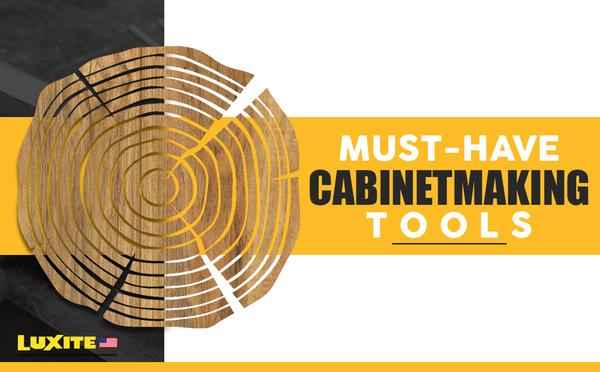
Whether you’re a novice woodworker or a professional cabinetmaker, you’ll appreciate having the proper tools for cabinetmaking. The right tools make the difference between efficient projects with tight joinery and sloppy jobs where nothing fits or aligns. Investing in the best tools brings a return that’s hard to beat.
If you’re like most people who love woodwork, you’ll have an interest in DIY cabinetmaking. You’ve probably read books on how to make cabinets. And, you’ll likely have watched TV shows and online videos on the subject. Something you’ll see is that cabinetmaking resources emphasize having the right cabinetmaking tools.
Some tools for cabinetmaking are complex and expensive. They’re difficult to afford and master but, once learned, they make the work much faster and more accurate. Other cabinetmaking tools are smaller and simpler. They require far less cash output to acquire. However, there are certain tools you need to make your own cabinets. Here’s a rundown on must-have cabinetmaking tools.
1. Clamps
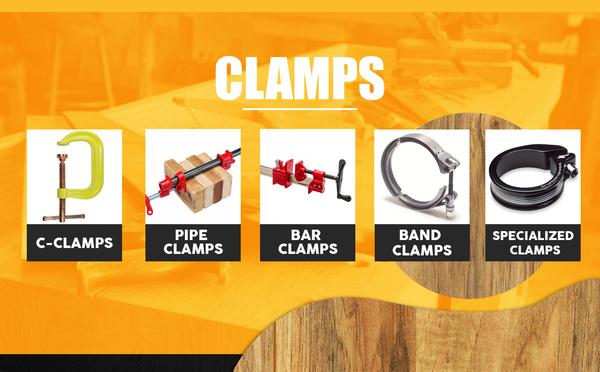
No cabinetmaking tools are handier than clamps. In fact, clamps replace your hands in many situations. A good clamp assortment is like having assistants in your shop. They hold materials in place while you’re measuring, cutting, joining and fastening your work.
There are countless clamp designs available at your favorite tool supply store. There’s a good reason for that. It’s because there’s no such thing as a one-size-fits-all clamp. There are too many different clamp applications. Here are the most common clamps you’ll find in a cabinetmaking workshop:
C-Clamps: These are the oldest mechanical clamp design. They’ve been around for hundreds of years. C-clamps have simple steel frames with an open throat controlled by a screw jaw. They come in a huge size range and various throat depths.
Pipe Clamps: You’d have a hard time building cabinets without pipe-clamps. They look just like their name — a typical iron pipe with one fixed jaw and an adjustable clamp face. Sizes range from short to as long as you can find a rigid metal pipe.
Bar Clamps: These irreplaceable cabinetmaking clamps use a metal bar frame instead of pipe. They combine the strength of a pipe clamp with the depth of a C-clamp. Many shops have a dozen or more bar clamps on hand.
Band Clamps: If you’re assembling large structures like cabinet boxes, band clamps make it easy to wrap and secure your work. Band clamps have malleable fabric straps and ratcheting clamp controls that allow you to carefully squeeze components.
Specialized Clamps: Cabinetmaking often requires specialized clamps. Two common and irreplaceable specialized clamps are the 3-way face clamp and the flush-and-flat face clamp. Both make tricky joints easier.
2. Table Saw
Table saws are a woodworking shop’s heart. Experienced craftspeople turn out amazing cuts on a table saw, and make cuts safely. Table saws are dangerous tools in the wrong hands. Fortunately, modern table saws have excellent safety devices in guards, guides, adjustments and controls.
If there’s one must-have anchor tool for cabinetmaking, it’s the table saw. There are a lot of table saw options available. Making the right choice for your shop can be confusing, but it doesn’t have to be. Here are the main table saw types used for cabinetmaking:
Cabinetmaking Table Saws: Like the name sounds, these table saws are centerpieces in a cabinetmaking shop. They’re heavy and rigid woodworking machines that fit between table extensions. Cabinetmaking table saws accept blade diameters from 7.5 inches to 12 inches and handle large pieces like 4-foot by 8-foot plywood sheets.
Contractor Table Saws: These are medium-duty machines that many cabinet makers regularly use. Contractor saws are portable, whereas cabinetmaking table saws stay fixed in the shop. Good quality contractor table saws make accurate cuts and also handle blade sizes up to 12 inches in diameter.
Benchtop Table Saws: Benchtop table saws might be small and compact, but they’re extremely handy for cabinetmaking work. They’re portable tools that make great resources when cutting small material on installation sites. Most benchtop table saws use 7.5-inch or 10-inch diameter blades.
3. Miter Saw
Miter saws are must-have cabinetmaking tools, right next to table saws. Where table saws sit rigidly and require feeding woodwork into the blade, miter saws bring the blade to the material. Miter saws aren’t designed for ripping material though. They’re operated by bringing a spinning blade down onto fixed materials.
You’ll often hear miter saws called chop-saws or cutoff saws. Actually, the word miter refers to making angled cuts for specific joints on frame or trim material. You’ll also hear of different miter saw versions that accommodate blades up to 12 inches in diameter. Here are the common miter saws available to cabinetmakers:
Standard Miter Saws: These tools have a fixed swing arm that adjusts from 0 to 45 degrees. That includes left and right turns for either angle on the work face. Standard miter saws are simple tools, but many cabinetmakers opt for their more complicated cousins.
Compound Miter Saws: Compound saws also make 90- and 45-degree cuts as well as any angle in between. But the magic to a compound miter saw is you can make cross angles on the work, so each cut has multiple geometric angles. Compound miter saws are the answer for crown molding work.
Sliding Compound Miter Saws: For the best variety of cut angles and work size, sliding compound miter saws are must-haves. Their sliding arms let them cut across much wider stock than fixed arm saws can handle. With a 12-inch blade, sliding miter saws cut material up to a foot wide.
4. High-Quality Saw Blades
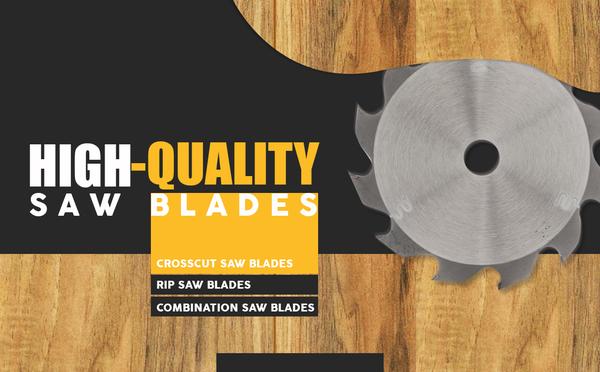
Even if you can’t afford the best quality table or miter saw, you can’t afford not to invest in high-quality saw blades. Sharp and precision saw blades make all the difference in the world compared to inferior blades. Your cuts are clean, without frays and make joinery easy.
LUXITE® carbide–tipped circular blades are must-haves in your cabinetmaking shop. These tools pay huge returns in performance and efficiency. Here are the top LUXITE® saw blades you must have in your shop:
Crosscut Saw Blades: LUXITE® fine-tooth crosscut saw blades are perfect for cutting fine-grained materials like plywood and melamine. They’re also excellent for across-the-grain miter cuts on trim. They come in two sizes — 10-inch 60-tooth and 12-inch 80-tooth. Like all LUXITE® blades, they are carbide-tipped.
Rip Saw Blades: For ripping with wood grain, nothing beats carbide-tipped rip blades from LUXITE®. They work quickly, efficiently and safely. Again, these blades come in two sizes — 10-inch 30-tooth and 12-inch 40-tooth.
Combination Saw Blades: You can get the best of both crosscut and ripping with LUXITE® carbide-tipped combination blades. If you have only one blade option for your shop, it should be a LUXITE® combination saw blade. These also come in two sizes — 10-inch 50-tooth and 12-inch 60-tooth.
5. Drilling Jig
Many cabinetmakers construct their own drilling jigs. As indispensable, must-have tools, drilling jigs help you make reliable, accurate and repeatable holes in your woodwork. They serve as both clamps to secure your work and guides to make sure you drill holes in exactly the right location with the proper angle.
You’ll find many pre-made drilling jigs available in tool supply outlets. Many are adjustable so you can customize your drilling to your needs, not some unworkable pre-set specification. Drilling jigs can be plastic, metal or wood. They also come in configurations compatible with certain cabinetmaking hardware like hinges, slides and pulls.
6. Scribe
Scribes are must-have cabinetmaking hand tools that let your mark wood or other materials, so you have a clear pattern for cutting, drilling or other operation. Scribes are excellent for transferring a known pattern to a surface destined to mate with it. In cabinetmaking, you’ll regularly use your scribe to trace and transfer irregular shapes like existing walls to new cabinet and counter joints.
Most scribes are metal and use a sharp point to inscribe a prescribed pattern into a new surface. Some scribes have pencil-like points to transfer erasable marks. You can also buy complex scribes that are similar to geometry compasses. With them, you can scribe angles, circles and ovals.
7. High-Speed Hinge Placement Tool
Placing hinges on your cabinet doors must be precise if you want excellent fit and finish. You can carefully transfer hinge points and attachment holes with a shop-made jig or a commercial scribe. However, those processes are slow and not always accurate.
Your must-have tool for fast and precise hinge placement is readily available online or in leading cabinetmaking tool supply stores. If you want speed and accuracy, then a high-speed hinge placement tool is a must-have. It works especially well with popular European hinges. Some even have three spring-loaded punches that you tap and transfer your drill points, making quick work of this task.
8. Self-Centering Bits
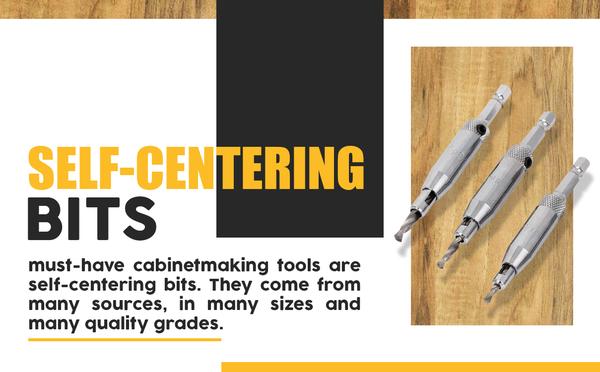
Other must-have cabinetmaking tools are self-centering bits. They come from many sources, in many sizes and many quality grades.
Your best-quality self-centering bits have precision-made hard carbon steel guide barrels with tungsten or carbide internal bits. The guide barrels align the bit with a hinge or fastener hole then line up your bit, so it makes a perfectly centered hole. There’s no bit slippage across a tight grain or error in hinge creep when you make self-centering bits a must-have in your shop.
9. Thin Kerf Dado Set
Cabinetmaking requires much finer cuts than general construction work. To build fine-quality cabinets, even one-sixty-fourth of an inch can make a difference. That’s especially true when you’re making cabinetry dados and need a precision-cut kerf.
Kerfs are the cut-out channels left by a saw blade that’s not set to completely sever the wood. You always make kerfs in drawer construction. You’ll also make kerfs to join cabinet boxes. To do this, use a dado blade that lets you adjust your kerf widths. Specialized dado blades allow you to make thin kerfs ranging in dados from one-sixteenth to one-quarter of an inch.
10. Magnetic Drawer Slide Mounting Tool
If you’ve tried mounting cabinet drawer slides to drawer and box frames, you’ll know how hard it is to be accurate without help. Magnetic drawer slide mounting tools solve that problem of needing three or more hands to hold the slide frame, the screw and your screw gun.
This must-have mounting tool is a metal jig you clamp to either your drawer or frame. It has a magnetic surface that attracts your metal slide and holds it in place while you screw the slide down. Once done, you unclamp the mounting tool and snap it away from the magnetized slide.
11. Drawer Pull Jig
Misplaced drawer pulls can indicate amateur work and stand out on your cabinetry face. Fortunately, there’s an easy fix when you use a drawer pull jig.
Most commercially available drawer pull jigs have multi-position, pre-set hole locations. Most have six standard off-sets as well as a common center spot. These inexpensive tools save you time during tedious pull attaching.
12. Drill Set
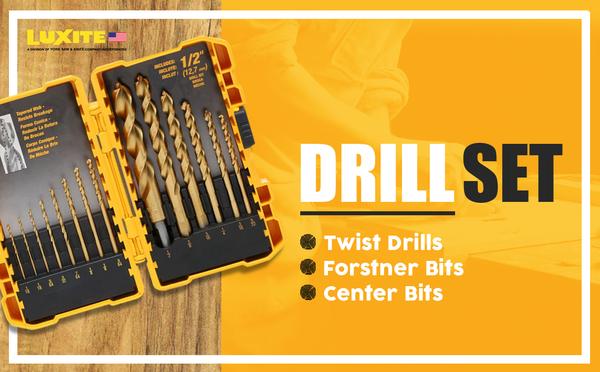
Drill sets are absolute must-haves in all cabinetry making toolboxes. The trick is having the right type of drill bit sets and the right quality. This is no place to skimp on your investment. You’ll pay more for good drill bits, but they’re worth every cent.
Not all drill bits are the same, by any means. You’ll need an assortment of drill bits if you’re serious about cabinetry. Here are the three common drill sets that you need in your toolkit:
Twist Drills: These are the standard drill bits you’ll see in every shop. They’re the most versatile, general-duty bits on the market. Twist drills range in size from one-sixty-fourth of an inch up to 1 inch. They’re available in many materials and come in both USA Imperial and Metric sizing.
Forstner Bits: Every cabinet maker needs quality Forstner drill bit sets. They let you make various sized holes without puncturing through the material. Forstner bits also leave a smooth bottom finish. If you’re setting barrels in European hinges, Forstner bits are must-haves.
Center Bits: These handy guys have centering guides at their tip. They allow accurate centering on a punch mark before starting your larger bit’s penetration. Center bits come in sets with various sizes and are necessary for precision drilling.
13. Hammer and Mallet
Hammers and mallets might seem like brute-force cabinetmaking tools. Yes, they’re used for force, but there’s nothing brutal about using hammers and mallets around fine cabinetry. The skill lies in the craftsperson’s hands as well as in the hammer and mallet design. Consider these hammers and mallets for your cabinet shop:
Conventional Claw Hammer: Nothing replaces a conventional claw hammer when it comes to making cabinets. You’ll use this old wooden-handled, steel-headed tool every day to drive and pull nails as well as gently tapping metal parts into place. Head weights of conventional claw hammers that range from 8 to 16 ounces are best for cabinetmaking.
Cross Peen Hammers: Instead of a curved, two-pronged fork on one end like a conventional claw hammer, cross peen hammers have a straight, solid wedge. Cross peen hammers are delicately-balanced persuaders for fitting metal parts including setting plane blades.
White Rubber Mallets: Rubber is an excellent surface for contacting cabinet works. The beauty of using white rubber rather than black is that these mallets won’t mark finished surfaces.
Wooden Mallets: Nothing replaces a wood mallet when it comes to driving chisels or pounding unexposed surfaces together. You can buy inexpensive wooden mallets at any supply house, but many cabinet makers enjoy their homemade models.
14. Combination Square
Combination squares are one of the most used tools in the cabinet shop. You’ll recognize combination squares from their design more so that the name. Combination squares are a blend of square, ruler and level. They’re adjustable devices that let you measure, transfer information, calculate angles and find levels.
Combination squares also serve as protractors and compasses. You can determine flatness or trueness of a cabinet surface with your combination square. Some complex combination squares have dial indicators for minute measurements.
Shop Online for Must-Have LUXITE® Carbide-Tipped Circular Saw Blades
LUXITE® brand carbide-tipped saw blades are must-have tools in your cabinetmaking shop. This is one area where it really pays to invest in top-quality tools. Every LUXITE® saw blade is American-made in York, Pa.
LUXITE® is the only blade manufacturer in America to make its blades from start to finish right here in the U.S. From design to sharpening, all our blades are made in our state-of-the-art facility. Since we have total control over the entire manufacturing process, you know you’ll be getting superior performance from LUXITE® blades. We carry a versatile blade selection for every cabinetmaking task. Check out our online store and view our lines of 10 and 12-inch crosscut, rip and combination carbide-tipped LUXITE® saw blades.
For more information on LUXITE® saw blades for your cabinetmaking needs, call us at 1.800.654.7297 or reach us using our online contact form.

